
Gloucester County is a county in the Commonwealth of Virginia. As of the 2020 census, the population was 38,711. Its county seat is Gloucester Courthouse. The county was founded in 1651 in the Virginia Colony and is named for Henry Stuart, Duke of Gloucester.
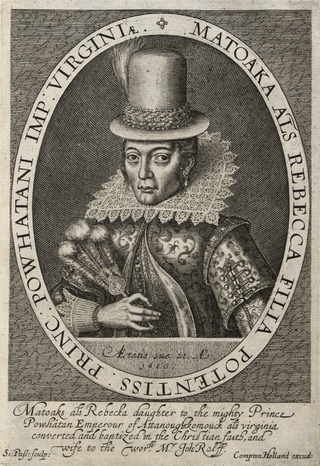
Pocahontas was a Native American woman belonging to the Powhatan people, notable for her association with the colonial settlement at Jamestown, Virginia. She was the daughter of Powhatan, the paramount chief of a network of tributary tribes in the Tsenacommacah, encompassing the Tidewater region of what is today the U.S. state Virginia.

The Powhatan people (;) are Native Americans who belong to member tribes of the Powhatan Confederacy, or Tsenacommacah. They are Algonquian peoples whose historic territories were in eastern Virginia.

Opechancanough was paramount chief of the Powhatan Confederacy in present-day Virginia from 1618 until his death. He had been a leader in the confederacy formed by his older brother Powhatan, from whom he inherited the paramountcy.

The York River is a navigable estuary, approximately 34 miles (55 km) long, in eastern Virginia in the United States. It ranges in width from 1 mile (1.6 km) at its head to 2.5 miles (4.0 km) near its mouth on the west side of Chesapeake Bay. Its watershed drains an area of the coastal plain of Virginia north and east of Richmond.

Powhatan, whose proper name was Wahunsenacawh, was the leader of the Powhatan, an alliance of Algonquian-speaking Native Americans living in Tsenacommacah, in the Tidewater region of Virginia at the time when English settlers landed at Jamestown in 1607.
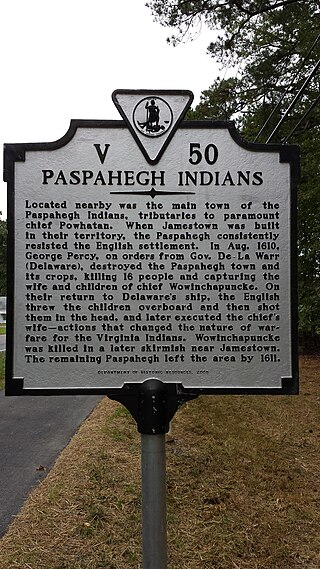
The Paspahegh tribe was a Native American tributary to the Powhatan paramount chiefdom, incorporated into the chiefdom around 1596 or 1597. The Paspahegh Indian tribe lived in present-day Charles City and James City counties, Virginia. The Powhatan Confederacy included Indigenous peoples of the Northeastern Woodlands who spoke a related Eastern Algonquian languages.

Weroance is an Algonquian word meaning leader or commander among the Powhatan confederacy of the Virginia coast and Chesapeake Bay region. Weroances were under a paramount chief called Powhatan. The Powhatan Confederacy, encountered by the colonists of Jamestown and adjacent area of the Virginia Colony beginning in 1607, spoke an Algonquian language. Each tribe of the Powhatan Confederacy was led by its own weroance. Most foreign writers who have come across a weroance only did so on a special occasion. This is the case because a foreigner's presence was special. John Smith noted that there are few differences between weroances and their subjects.
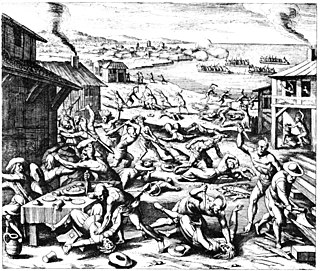
The Indian massacre of 1622 took place in the English colony of Virginia on 22 March 1622. English explorer John Smith, though he was not an eyewitness, wrote in his History of Virginia that warriors of the Powhatan "came unarmed into our houses with deer, turkeys, fish, fruits, and other provisions to sell us"; they then grabbed any tools or weapons available and killed all English settlers they found, including men, women, and children of all ages. Opechancanough, chief of the Powhatan Confederacy, led a coordinated series of surprise attacks that ended up killing a total of 347 people — a quarter of the population of the Colony of Virginia.

The Pamunkey Indian Tribe is one of 11 Virginia Indian tribal governments recognized by the Commonwealth of Virginia, and the state's first federally recognized tribe, receiving its status in January 2016. Six other Virginia tribal governments, the Chickahominy, the Eastern Chickahominy, the Upper Mattaponi, the Rappahannock, the Monacan, and the Nansemond, were similarly recognized through the passage of the Thomasina E. Jordan Indian Tribes of Virginia Federal Recognition Act of 2017 on January 12, 2018. The historical people were part of the Powhatan paramountcy, made up of Algonquian-speaking nations. The Powhatan paramount chiefdom was made up of over 30 nations, estimated to total about 10,000–15,000 people at the time the English arrived in 1607. The Pamunkey nation made up about one-tenth to one-fifteenth of the total, as they numbered about 1,000 persons in 1607.
The Chickahominy are a federally recognized tribe of Virginian Native Americans who primarily live in Charles City County, located along the James River midway between Richmond and Williamsburg in the Commonwealth of Virginia. This area of the Tidewater is not far from where they were living in 1600, before the arrival of colonists from England. They were officially recognized by the state in 1983 and by the federal government in January 2018.

The Native American tribes in Virginia are the Indigenous peoples whose tribal nations historically or currently are based in the Commonwealth of Virginia in the United States of America.

The Mattaponi tribe is one of only two Virginia Indian tribes in the Commonwealth of Virginia that owns reservation land, which it has held since the colonial era. The larger Mattaponi Indian Tribe lives in King William County on the reservation, which stretches along the borders of the Mattaponi River, near West Point, Virginia.
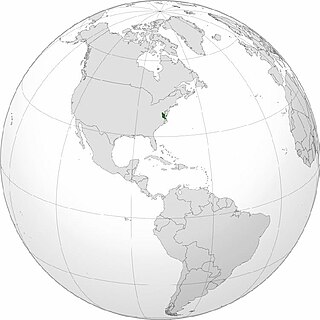
Tsenacommacah is the name given by the Powhatan people to their native homeland, the area encompassing all of Tidewater Virginia and parts of the Eastern Shore. More precisely, its boundaries spanned 100 miles (160 km) by 100 miles (160 km) from near the south side of the mouth of the James River all the way north to the south end of the Potomac River and from the Eastern Shore west to about the Fall Line of the rivers.

Powhatan's Chimney is located at present day Wicomico, in Gloucester County, Virginia, United States.
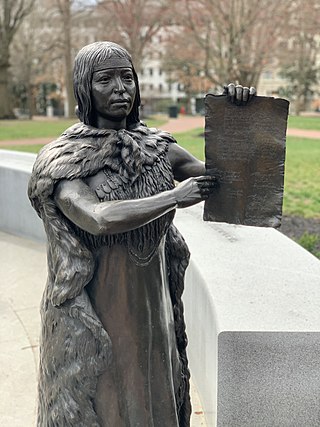
Cockacoeske was a 17th-century leader of the Pamunkey tribe in what is now the U.S. state of Virginia. During her thirty-year reign, she worked with the English colony of Virginia, trying to recapture the former power of past paramount chiefs and maintain peaceful unity among the several tribes under her leadership. She was the first of the tribal leaders to sign the Virginia-Indian Treaty of Middle Plantation. In 2004 Cockacoeske was honored as one of the Library of Virginia's "Virginia Women in History".

The Anglo–Powhatan Wars were three wars fought between settlers of the Colony of Virginia and the Powhatan People of Tsenacommacah in the early 17th century. The first war started in 1609 and ended in a peace settlement in 1614. The second war lasted from 1622 to 1632. The third war lasted from 1644 until 1646 and ended when Opechancanough was captured and killed. That war resulted in a defined boundary between the Indians and colonial lands that could only be crossed for official business with a special pass. This situation lasted until 1677 and the Treaty of Middle Plantation which established Indian reservations following Bacon's Rebellion.
Necotowance was Werowance (chief) of the Pamunkey tribe and Paramount Chief of the Powhatan Confederacy after Opechancanough, from 1646 until his death sometime before 1655. Necotowance signed a treaty with the Colony of Virginia in 1646, at which time he was addressed by the English as "King of the Indians."
Kiskiack was a Native American tribal group of the Powhatan Confederacy in what is present-day York County, Virginia. The name means "Wide Land" or "Broad Place" in the native language, one of the Virginia Algonquian languages. It was also the name of their village on the Virginia Peninsula.





















